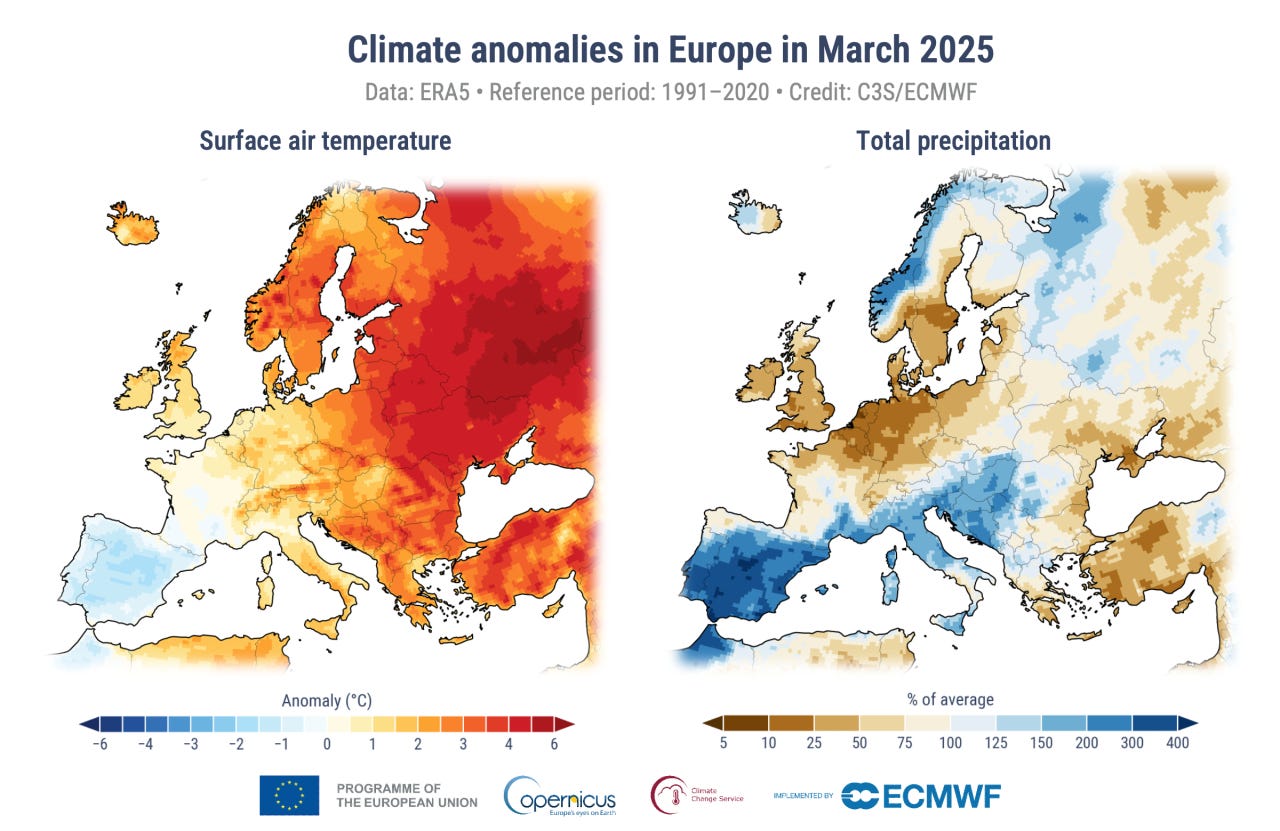Hot Planet Update: Record March in Europe, La Niña Ends, Deadly Storms in U.S., Groundbreaking AC Startup, Pro-Coal Trump Cuts Climate Assessment and Targets State Climate Laws, & More
A roundup of what happened, why it matters, and key context for climate change news during the week of April 6-11.

Welcome to “Hot Planet Update,” a series on Reality Studies that recaps the biggest news in climate from the last week. Using a “smart brevity” format, Last Week in Climate recaps are designed to keep you up-to-date on the latest news and provide key context.
The first half of each HPU is available for free subscribers, and the full post is available to paid subscribers. Subscribe now so you never miss an installment!
1. Europe Shatters March Heat Records
👉 Europe saw its hottest March ever as global temperatures neared all-time highs.
March 2025 was Europe’s warmest March, averaging 2.41°C above the 1991–2020 norm. Globally it was about 1.6°C warmer than pre-industrial levels, marking one of the hottest Marches on record.
This was the 20th out of 21 months to exceed 1.5°C of warming on a monthly basis, underscoring how frequently the world is hitting the Paris Agreement’s aspirational limit.
Arctic sea ice saw its lowest March extent in 47 years of satellite monitoring, highlighting accelerating polar warming.
Why it matters: These record temperatures are a red flag from the climate system, signaling that global warming is not a distant threat but a current reality – with Europe warming faster than any other continent, climate extremes and impacts are expected to worsen.
MUD\WTR: Right now, get 30% off on starter packs using this link.
There’s four different adaptogen blends to choose from, but my current favorite is :rest, which helps me ramp down from long days and feel ready for sleep.
2. Trump Seeks a “Beautiful Clean Coal” Comeback
👉 The U.S. President signed executive orders to revive coal mining and roll back climate rules.
President Trump issued four executive orders aimed at expanding coal mining on federal lands and scrapping Biden-era emissions curbs on power plants. He touted coal as “beautiful” and “clean,” directing agencies to eliminate policies that discourage coal power.
The orders fast-track leases and permits for coal projects and nullify regulations meant to cut greenhouse gases. This marks a sharp U-turn from the Biden administration’s climate agenda.
Even coal-friendly Republicans doubt this will truly resurrect the industry—nearly 100 coal plants retired during Trump’s first term despite similar efforts. Market forces (cheap gas, renewables) still favor cleaner energy, raising skepticism about coal’s “comeback.”
Why it matters: This is a major setback for U.S. climate action. Reviving coal – the dirtiest fossil fuel – will increase carbon emissions if successful. It also sends a signal internationally that the world’s second-largest emitter is prioritizing fossil fuels over clean energy, potentially undermining global climate progress.
3. La Niña Ends, El Niño on the Horizon
👉 The Pacific’s multi-year cool spell is over, potentially paving the way for a warming El Niño and new weather extremes.
The NOAA Climate Prediction Center confirmed that La Niña has officially fizzled out. Sea surface temps in the equatorial Pacific have returned to neutral levels after three weak La Niña months. This basically means the Pacific is no longer in the cooler phase that it’s been stuck in for the past few years.
Forecasters expect neutral conditions to persist into spring, with a decent chance that an El Niño (the warm phase) could develop later in 2025. An El Niño occurs when Pacific waters warm above normal, and it tends to shift weather patterns worldwide, often bringing hotter global temperatures.
Notably, even under La Niña influence, March 2025 was the 3rd-warmest March on record globally. If El Niño arrives, it could push planetary warmth to new records, since El Niño years usually boost global average temperature. Scientists are bracing for the possibility of more extreme heat, droughts, and floods in various regions as the climate system gets an extra nudge from a brewing El Niño.
Why it matters: La Niña’s end could turbocharge global warming’s effects in the short term. El Niño conditions later this year would add heat on top of human-caused climate change, making 2025 or 2026 contenders for the hottest year(s) ever. Communities may need to prepare for disruptive weather swings (e.g., El Niño can bring heavy rain to some drought-prone areas but intense drought to others). It’s a reminder of how natural climate patterns, layered on man-made warming, can swing the pendulum of extreme weather.
What is Post-Growth Economics? Rethinking Prosperity Beyond GDP Growth
A world in flux. Climate change, biodiversity loss, resource depletion, rising inequality—the litany of 21st-century crises can feel overwhelming, and fast. From record-high atmospheric CO₂ levels to mass extinction trends, evidence abounds that humanity is pushing beyond the planet’s limits. Underpinning many of these ch…
4. Climate Aid Falling Short in Senegal
👉 Senegal is battling climate impacts with only a trickle of the global funds it was promised.
In 2009, wealthy nations pledged $100 billion per year to help developing countries tackle climate change. But much of that money never reached the frontlines. Tracking where it went is hard, and in places like Senegal the effects of that funding are scarcely seen.
In Senegal, rising seas are eroding coastlines and droughts are hitting farmers, yet the communities affected have received little support. A report this week highlighted how Senegalese villages are trying to adapt—building seawalls, altering farming practices—largely with limited resources, while waiting for international aid that’s been slow to arrive.
Critics point out a transparency gap: it’s “tough to verify” if climate aid pledges are fulfilled. Money often gets counted via loans or projects that don’t directly help those most vulnerable. The upshot is the world’s poorest, who did least to cause climate change, aren’t getting the help promised to cope with its damages.
Why it matters: Senegal’s story is emblematic of many developing nations. The climate finance gap threatens to widen global inequality; if rich countries don’t deliver support, millions will be hit harder by floods, storms, and heat with no safety net. This is not only an issue of climate justice, it also could hinder global stability, as communities under climate stress face economic and social crises.
Mission Farms CBD: My favorite CBD, full stop. They farm the hemp organically on a small Oregon farm, tend every plant by hand, and test for purity four times: the soil, the hemp, the hemp-extract, and the final products.
Go to this link and sign up for emails to get 25% off + free shipping on your first order.
5. Storms Spawn Deadly Tornadoes and Floods in U.S. Heartland
👉 A barrage of severe storms tore through the South and Midwest, causing deadly flash floods and tornado outbreaks.
Days of torrential rain and violent storms from Texas to Ohio left communities waterlogged and devastated. Rivers spilled over into towns as the system killed at least 18 people across seven states, including Kentucky, Tennessee, and Arkansas.
Hard-hit Kentucky saw its capital, Frankfort, inundated. Crews navigated swamped streets by boat as floodwaters swirled into homes and businesses. Parts of Tennessee received over a foot of rain in just days, shattering rainfall records and triggering what officials called “generational” flooding emergencies.
The storm front also unleashed dozens of tornadoes across the central U.S., with the National Weather Service confirming roughly 60 twisters touched down. Entire neighborhoods were shredded by twisters even as others drowned in flash floods—a double punch consistent with spring severe weather that experts say is intensified by climate change.
Why it matters: This event is a sobering example of climate-fueled extreme weather. Warmer air holds more moisture, so rainfall extremes are increasing, turning what used to be once-in-1000-year rainstorms into more common occurrences. The outbreak underscores the need for resilient infrastructure and disaster planning as the risk of deadly flooding and tornado clusters rises in a warming climate.
Want to read the remaining 5 stories? Join Reality Studies as a paid subscriber:








